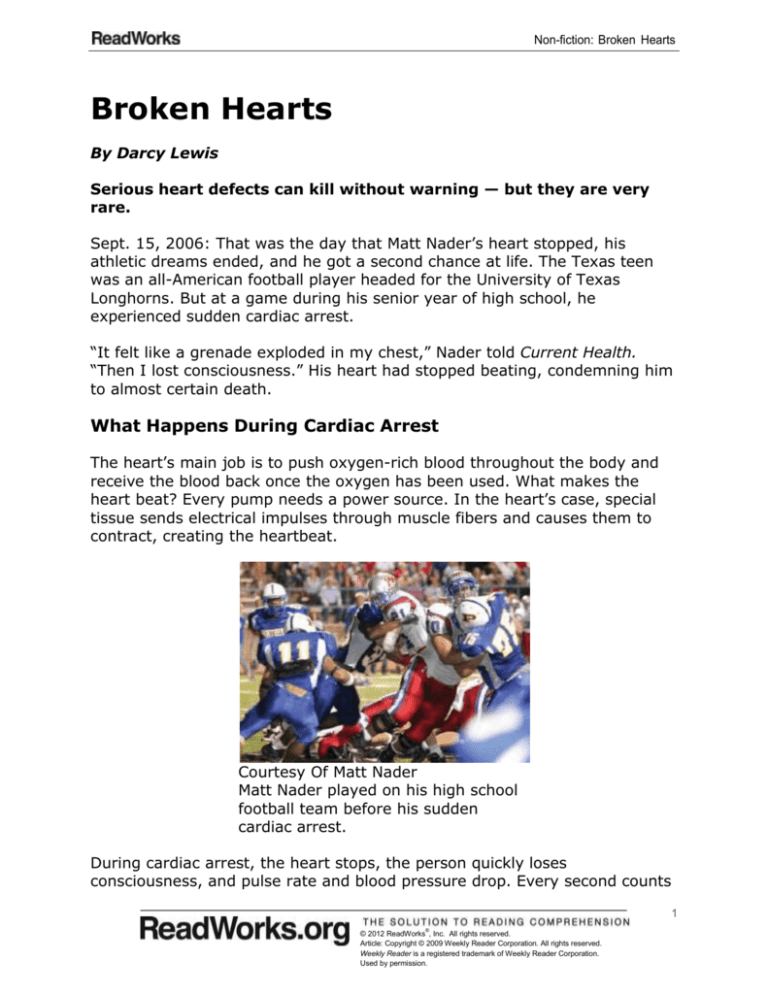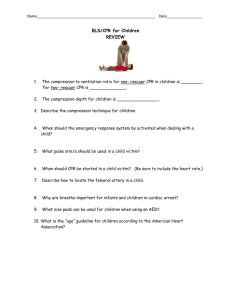
Non-fiction: Broken Hearts
Broken Hearts
By Darcy Lewis
Serious heart defects can kill without warning — but they are very
rare.
Sept. 15, 2006: That was the day that Matt Nader’s heart stopped, his
athletic dreams ended, and he got a second chance at life. The Texas teen
was an all-American football player headed for the University of Texas
Longhorns. But at a game during his senior year of high school, he
experienced sudden cardiac arrest.
“It felt like a grenade exploded in my chest,” Nader told Current Health.
“Then I lost consciousness.” His heart had stopped beating, condemning him
to almost certain death.
What Happens During Cardiac Arrest
The heart’s main job is to push oxygen-rich blood throughout the body and
receive the blood back once the oxygen has been used. What makes the
heart beat? Every pump needs a power source. In the heart’s case, special
tissue sends electrical impulses through muscle fibers and causes them to
contract, creating the heartbeat.
Courtesy Of Matt Nader
Matt Nader played on his high school
football team before his sudden
cardiac arrest.
During cardiac arrest, the heart stops, the person quickly loses
consciousness, and pulse rate and blood pressure drop. Every second counts
1
®
© 2012 ReadWorks , Inc. All rights reserved.
Article: Copyright © 2009 Weekly Reader Corporation. All rights reserved.
Weekly Reader is a registered trademark of Weekly Reader Corporation.
Used by permission.
Non-fiction: Broken Hearts
once the brain and other organs lose their oxygen supply. Most people will
die if they don’t get help within four to six minutes. Only 8 percent who have
cardiac arrest outside a hospital make it home again, according to the
American Heart Association.
What About Teens?
Any death from cardiac arrest is tragic, but the death of a teen is especially
devastating. Unfortunately, each year a small number of teens—often
athletes—experience sudden cardiac arrest. In many cases, they have
undiagnosed heart problems. In others, no explanation is ever found.
Athletes seem to be at a slightly higher risk because physical activity may
overtax a vulnerable heart.
Dr. Barry Maron, a cardiologist with the Minneapolis Heart Institute
Foundation, maintains the Sudden Death in Athletes U.S. Registry. “Each
year, about 75 young athletes die from sudden cardiac arrest,” he says.
According to the U.S. Census Bureau’s 2008 estimate, there are more than
21 million people ages 15 to 19. “These are highly tragic events,” Maron
notes, “but fortunately rare.”
The registry shows that a majority of those deaths were due to heart
disease. Hypertrophic cardiomyopathy (HCM)—a dangerous thickening of the
heart muscle—is the leading cause of sudden cardiac arrest in young
athletes. “A normal heart has orderly sheets of muscle, but an HCM heart’s
muscle fibers are intertwined irregularly,” explains Dr. Theodore Abraham,
director of the Johns Hopkins Hypertrophic Cardiomyopathy Clinic in
Baltimore. “These irregular fibers and the associated scarring can interfere
with a regular heartbeat.”
That’s what happened to Connor Gwinn. On Feb. 22, 2009, the 18-year-old
student at James Madison University in Virginia was jogging on an indoor
track when he collapsed. A student in the next lane started CPR, while gym
staff prepared to shock his heart with an automated external defibrillator
(AED). After three shocks, Gwinn’s heart returned to a regular rhythm. “It
turns out that both my 30-year- old brother and I have HCM and never knew
it,” he says. “But I’d always gotten winded easily, and my face reddened
during physical activity due to my thickened heart.”
2
®
© 2012 ReadWorks , Inc. All rights reserved.
Article: Copyright © 2009 Weekly Reader Corporation. All rights reserved.
Weekly Reader is a registered trademark of Weekly Reader Corporation.
Used by permission.
Non-fiction: Broken Hearts
Courtesy Of Matt Nader
Nader after placement of
a defibrillator. He is not
able to play for the
University of Texas
Longhorns, but Nader is
on the sidelines for
every practice and
game.
Nader’s heart seems normal, and his cardiac arrest has never been
explained. As with Gwinn, CPR and a defibrillator saved him. “My school had
bought an AED four years earlier but had never used it,” he says. “I wouldn’t
be here if they didn’t have that AED.”
Abraham recommends that all schools have defibrillators. “These lifesaving
devices are basically foolproof,” he says. “All you do is apply the chest
patches. The AED shocks only when needed.”
Can Screening Help?
Saving someone from cardiac arrest is wonderful, but preventing cardiac
arrest would be even better. “If you just go by symptoms, you will not find a
majority of kids with serious heart defects because most don’t have
symptoms,” says Abraham. Gwinn’s symptoms, present for years, were
mild, and Nader’s only complaint was unusual fatigue the day of his cardiac
arrest. Abraham’s solution: screening instead of waiting for attacks.
That is where the controversy begins. How do you screen for symptomless
conditions? The American Heart Association suggests a physical exam and a
family-history questionnaire for high school athletes, plus an
electrocardiogram if justified. Abraham would add a heart ultrasound—a
3
®
© 2012 ReadWorks , Inc. All rights reserved.
Article: Copyright © 2009 Weekly Reader Corporation. All rights reserved.
Weekly Reader is a registered trademark of Weekly Reader Corporation.
Used by permission.
Non-fiction: Broken Hearts
scan using sound waves—because, he says, some problems show up on one
test but not others.
Maron has some concerns about screening. He notes that most people who
experience cardiac arrest are not athletes, so limiting it just to athletes
would be discriminatory. Although electrocardiograms can identify people
with disease, Maron says, they can also lead to unnecessary anxiety and
additional tests. Finally, he asks an important question: Who will pay for it?
“Health insurance companies do not,” Maron asserts. Plus, to screen every
young person in the country may take more doctors and equipment than are
available. “It’s not just a cost issue, it’s a resource issue,” explains Maron.
Abraham acknowledges that the screening could cost up to $1,000 in a
doctor’s office. So he launched the Hopkins Heart Hype Program with
volunteer nurses and physicians, offering free screenings to high school
athletes. “We can do a complete screening in 20 minutes,” Abraham says.
“This [program] will let us know if focused, low-cost screening is as good as
doing the full study. If true, screenings can then be done at one-tenth the
usual cost.”
After screening about 700 teens, Abraham’s team found five with lifethreatening cardiac conditions. That may not sound like a lot. But the
screenings also found dozens with other heart conditions. “They need to
know this information and in some cases may need to see a doctor,”
Abraham notes.
A Second Chance
As for Nader and Gwinn, both are in college enjoying life, now with tiny
defibrillators implanted in their chests in case of another cardiac arrest.
Gwinn enjoys being moderately active: “No marathon running or rock
climbing for me, but I can jog lightly or do toning exercises.”
Nader, 20, still works with his beloved Longhorns, now as a student
assistant. “I’m here because people around me knew what to do,” he says.
“I can’t even put my gratitude into words.”
Save A Life: You Can Do It!
Nearly 800 people suffer sudden cardiac arrest every day, according to the
American Heart Association. It can happen anywhere—at home, at work, or
in public places such as schools or airports.
4
®
© 2012 ReadWorks , Inc. All rights reserved.
Article: Copyright © 2009 Weekly Reader Corporation. All rights reserved.
Weekly Reader is a registered trademark of Weekly Reader Corporation.
Used by permission.
Non-fiction: Broken Hearts
iStock
Fortunately, you can help. First, learn cardiopulmonary resuscitation (CPR).
That is a simple way to press on someone’s chest to pump blood to the heart
and brain until an electrical shock can reset the heart into a steady rhythm.
Your school may offer classes. If not, look for a class in your community
from either the American Red Cross or the American Heart Association. You
should also learn how defibrillators work.
Visit www.bethebeat.heart.org, an American Heart Association Web site that
uses games and quizzes to teach the basics of CPR and defibrillators. There
is even a downloadable playlist of CPR-friendly, 100-beat-per-minute songs.
Connor Gwinn, who suffered sudden cardiac arrest in 2009, is grateful to the
students who performed CPR on him and shocked his heart. “When we all
saw each other later at a Red Cross banquet, we all burst into tears,” he
says. “They did a wonderful thing for me.”
Defibrillator Laws in Your State
Many states require places such as schools and airports to install
defibrillators. To find out whether your state does, visit www.ncsl.org and
enter AEDs into the Web site’s search engine.
5
®
© 2012 ReadWorks , Inc. All rights reserved.
Article: Copyright © 2009 Weekly Reader Corporation. All rights reserved.
Weekly Reader is a registered trademark of Weekly Reader Corporation.
Used by permission.
Non-fiction: Broken Hearts
Eliza Snow/iStock
Call 9-1-1!
If you see someone collapse, get the pros there ASAP. If you’re alone, call 91-1 first, then start CPR. If someone else is there, one can call 9-1-1 while
the other person starts CPR immediately.
6
®
© 2012 ReadWorks , Inc. All rights reserved.
Article: Copyright © 2009 Weekly Reader Corporation. All rights reserved.
Weekly Reader is a registered trademark of Weekly Reader Corporation.
Used by permission.
Questions: Broken Hearts
Name:
Date:
1. All of the following happen during cardiac arrest EXCEPT
A
B
C
D
the heart beats faster
a loss of consciousness occurs
the pulse rate drops
the blood pressure drops
2. The passage describes the problem of undiagnosed heart defects in teen athletes.
What is one way that Dr. Theodore Abraham is working to solve the problem?
A
B
C
D
He
He
He
He
is making sure that all Americans receive electrocardiograms.
is traveling to schools across the country to speak about heart disease.
bought defibrillators and other lifesaving devices for hundreds of schools.
launched a program that offers free screenings to high school athletes.
3. After reading the passage, what can you conclude about cardiopulmonary
resuscitation (CPR)?
A
B
C
D
Anyone can learn this life-saving technique.
It takes years to learn how to perform CPR.
Only medical experts should perform CPR.
The average person doesn’t need to learn CPR.
4. Read this sentence from the passage: “His heart had stopped beating, condemning
him to almost certain death.”
In this sentence, the word condemning means
A
B
C
D
extending help to someone
sentencing to punishment
rewarding for good behavior
examining very carefully
5. Which statements best expresses the main idea of this passage?
A
B
C
D
Most children with serious heart defects don’t exhibit any symptoms.
A small number of teens experience sudden cardiac arrest each year.
Matt Nader has not been able to play football since his cardiac arrest.
Every second counts once the brain and other organs lose their oxygen supply.
1
®
© 2012 ReadWorks , Inc. All rights reserved.
Questions: Broken Hearts
6. What causes the heart to beat?
7. Why are automated external defibrillators (AEDs) important? How do you know? Give
examples from the passage to support your answer.
8. The question below is an incomplete sentence. Choose the word that best completes
the sentence.
Eighteen-year-old Connor Gwinn collapsed
A
B
C
D
he was jogging on an indoor track.
while
and
but
than
2
®
© 2012 ReadWorks , Inc. All rights reserved.
Questions: Broken Hearts
9. Answer the following questions based on the sentence below.
On September 15, 2006, people saved Matt Nader’s life by performing CPR and using a
defibrillator to bring his heart back to life.
Who?
(did) What? saved Matt Nader’s life
When?
How?
10. Vocabulary Word: vulnerable: susceptible to injury.
Use the vocabulary word in a sentence:
3
®
© 2012 ReadWorks , Inc. All rights reserved.
Teacher Guide & Answers: Broken Hearts
4
© 2012 ReadWorks®, Inc. All rights reserved.








